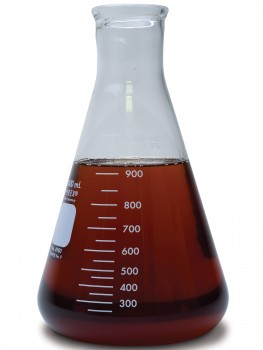Synthetic Diet
Barring any heated debates, the answer to “Should I switch to a synthetic oil?” is simply “yes.” The additional cost of upgrading to a synthetic oil blend will be recovered over time with increased fuel efficiency, better component longevity and reduced oil-change frequency. [pullquote]“SHOULD I SWITCH TO A SYNTHETIC OIL?”[/pullquote]Since synthetic oils are usually produced from the same grades of high-quality base stock, the quality and performance factors are found in the manufacturer’s oil additive package. It’s these proprietary additive packages that neutralize by-products of combustion, reduce oil foaming tendencies and increase anti-wear and anti-oxidant presence. The end result is an increase in power production while maintaining a high-level of engine component protection.
Light Makes Might
 An oil’s viscosity rating is an indicator of its resistance to flow. For the layman, it’s easiest to think of viscosity as the “thickness” of an oil. Since the advent of multi-grade oils, there have been quite a few misconceptions as to what oil a specific application should use. A straight 30-weight oil has a particular viscosity at a standard reference operating temperature. The “W” prefix placed in front of multi-grade oil weight ratings indicates how the oil would perform under a colder (“w” for winter) initial temperature. So, the multi-grade oil allows the oil to flow like a “lighter” oil at startup to prevent wear from dry conditions, while retaining the operating temperature viscosity of a straight weight. With that in mind, it’s easier to understand how viscosity inhibitors enable a 5W-30 to offer the protection of a 5-weight oil at startup and a 30-weight oil at normal operating termperatures. This is how oil manufacturers can recommend substitutions of lighter oil based on climate. If you live in a relatively temperate region that doesn’t see freezing or extremely cold temperatures for extended periods, the manufacturer might recommend a multi-grade oil that has the same operating temperature weight with a lighter “W” rating; for example, you can safely run a 5W-30 oil instead of the factory recommended 10W-30 if you live in the beach area of Southern California. Consequently, you can also run a higher operating temp weight for more engine protection if you live in a warmer climate – a 10W-40 in place of the factory recommended 10W-30. When in doubt as to which oil you can run, always ask the manufacturer of the oil you want to run as they have the most information and experience with their product line.
An oil’s viscosity rating is an indicator of its resistance to flow. For the layman, it’s easiest to think of viscosity as the “thickness” of an oil. Since the advent of multi-grade oils, there have been quite a few misconceptions as to what oil a specific application should use. A straight 30-weight oil has a particular viscosity at a standard reference operating temperature. The “W” prefix placed in front of multi-grade oil weight ratings indicates how the oil would perform under a colder (“w” for winter) initial temperature. So, the multi-grade oil allows the oil to flow like a “lighter” oil at startup to prevent wear from dry conditions, while retaining the operating temperature viscosity of a straight weight. With that in mind, it’s easier to understand how viscosity inhibitors enable a 5W-30 to offer the protection of a 5-weight oil at startup and a 30-weight oil at normal operating termperatures. This is how oil manufacturers can recommend substitutions of lighter oil based on climate. If you live in a relatively temperate region that doesn’t see freezing or extremely cold temperatures for extended periods, the manufacturer might recommend a multi-grade oil that has the same operating temperature weight with a lighter “W” rating; for example, you can safely run a 5W-30 oil instead of the factory recommended 10W-30 if you live in the beach area of Southern California. Consequently, you can also run a higher operating temp weight for more engine protection if you live in a warmer climate – a 10W-40 in place of the factory recommended 10W-30. When in doubt as to which oil you can run, always ask the manufacturer of the oil you want to run as they have the most information and experience with their product line.
| TYPES OF TYPICAL ADDITIVES | OIL PERFORMANCE CRITERIA |
|---|---|
| Acid Neutralizers | Low Volatility |
| Anti-Foaming | High Film Strength |
| Anti-Oxidant | High Viscosity Index |
| Anti-Wears | High Lubricity |
| Corrosion Inhibitors | High Detergency |
| Detergents | High Friction Reduction |
| Dispersants | High Flash Point |
| Film Strength Modifiers | High Oxidation Resistance |
| Friction Reducers | Low Foaming |
| Viscosity Improvers |
The Bottom(end) Line
Your engine requires oil and a complex lubrication system. If you take the time to protect and enhance your engine’s lubricating system, you will be rewarded with increased horsepower, better fuel economy and a longer- running engine.



